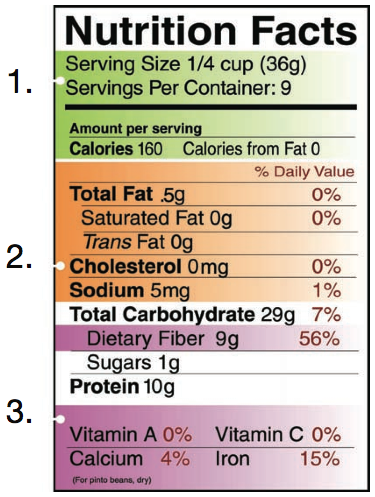3 Steps to Read Nutrition Facts Label
 Section 1 - Calorie and Portion Awareness• Serving size - How big is this serving for the number of calories it contains? Remember, MyPlate advises that people avoid oversized portions.• Servings per container - Is that big chocolate bar really 3 servings? Make sure you know how many calories you are really eating!• Calories per serving - Find out how many calories you need per day to maintain your cur- rent body weight (pounds):For sedentary people:Weight x 14 = estimated calories per day; this is about 2000 calories for someone 145 pounds.For moderately active people:Weight x 16 = estimated calories per dayFor more active people:Weight x 17 = estimated calories per daySection 2 - Beware of Heart Stoppers• Check the % Daily Value – 5% or less is low while 20% or more is high.• Fat - Keep total fat intake between 20 to 35 percent of calories, with most fats coming from fish, nuts, and vegetable oils.• Saturated fat - This fat increases bad cholester- ol which can lead to a build up in your arteries. Limit saturated fat consumption to 10% or less of your calorie, which means about 16 grams or less per day for most people.• Trans fat - This fat is found mostly in processed foods that contain partially hydrogenated oils. It has been shown to increase bad cholesterol and lower good cholesterol. This one is trouble for your heart. Most health authorities set the upper limit for this fat at 0 calories or less than 1%.• Cholesterol is found in only in products from animals such as meat and dairy products. It has also been shown to raise bad cholesterol. Keep consumption to 300 mg or less per day.• Sodium is found in really high amounts amounts in processed and prepared foods. Excess sodium in the diet leads to high blood pressure and other health problems.Section 3 - The Good Stuff• Dietary fiber is something we can all use more of in our diets. It aids weight loss, helps lower cholesterol, helps control blood sugar and keeps our digestive tracts on the move. Aim for 14 grams per day for every 1,000 calories you consume. Increase slowly and drink plenty of water.• Vitamins and minerals listed on the food label help us decide if a product contains important nutrients. Follow the tips and instructions at choosemyplate.gov to ensure you are getting adequate nutrients and enough variety in your diet.Examine the Facts1. Count calories 2. Check these for the heart. 3. Is this nutritionally valuable?
Section 1 - Calorie and Portion Awareness• Serving size - How big is this serving for the number of calories it contains? Remember, MyPlate advises that people avoid oversized portions.• Servings per container - Is that big chocolate bar really 3 servings? Make sure you know how many calories you are really eating!• Calories per serving - Find out how many calories you need per day to maintain your cur- rent body weight (pounds):For sedentary people:Weight x 14 = estimated calories per day; this is about 2000 calories for someone 145 pounds.For moderately active people:Weight x 16 = estimated calories per dayFor more active people:Weight x 17 = estimated calories per daySection 2 - Beware of Heart Stoppers• Check the % Daily Value – 5% or less is low while 20% or more is high.• Fat - Keep total fat intake between 20 to 35 percent of calories, with most fats coming from fish, nuts, and vegetable oils.• Saturated fat - This fat increases bad cholester- ol which can lead to a build up in your arteries. Limit saturated fat consumption to 10% or less of your calorie, which means about 16 grams or less per day for most people.• Trans fat - This fat is found mostly in processed foods that contain partially hydrogenated oils. It has been shown to increase bad cholesterol and lower good cholesterol. This one is trouble for your heart. Most health authorities set the upper limit for this fat at 0 calories or less than 1%.• Cholesterol is found in only in products from animals such as meat and dairy products. It has also been shown to raise bad cholesterol. Keep consumption to 300 mg or less per day.• Sodium is found in really high amounts amounts in processed and prepared foods. Excess sodium in the diet leads to high blood pressure and other health problems.Section 3 - The Good Stuff• Dietary fiber is something we can all use more of in our diets. It aids weight loss, helps lower cholesterol, helps control blood sugar and keeps our digestive tracts on the move. Aim for 14 grams per day for every 1,000 calories you consume. Increase slowly and drink plenty of water.• Vitamins and minerals listed on the food label help us decide if a product contains important nutrients. Follow the tips and instructions at choosemyplate.gov to ensure you are getting adequate nutrients and enough variety in your diet.Examine the Facts1. Count calories 2. Check these for the heart. 3. Is this nutritionally valuable?


